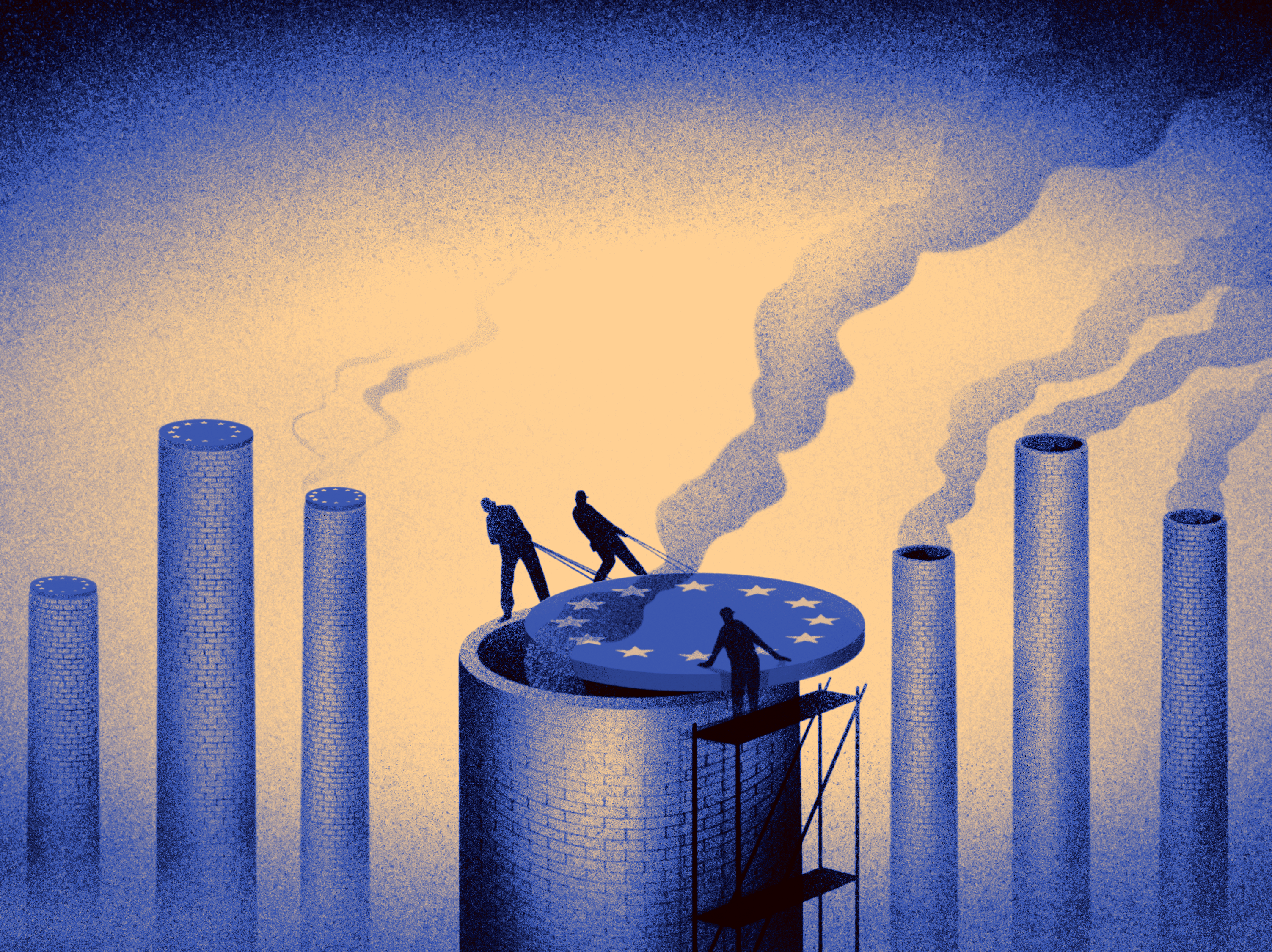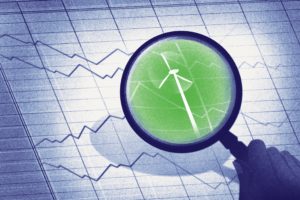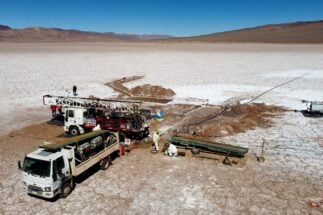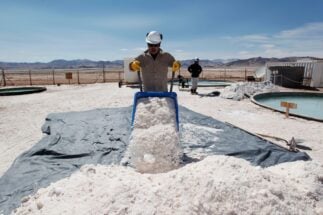As part of its plan to cut emissions 55% by 2030, the EU plans on introducing a carbon levy on imports of certain emission-intensive products into the EU. The idea behind the “carbon border adjustment mechanism” (CBAM) is to avoid “carbon leakage”, a situation where, because of the high cost of European climate regulation, industrial producers move their factories to regions with lower constraints on carbon emissions than the EU.
Currently, the EU protects against such leakage by allocating emission allowances to its domestic industrial plants, and providing subsidies at Member State level to compensate for higher electricity costs due to carbon pricing. In its proposed form, the CBAM would be phased in gradually between 2026 and 2035, increasing by 10% each year. At the same time, free allowances will be phased out of the EU emissions trading system at a similar pace.
Here we analyse the combined effect of phasing in the CBAM and phasing out other carbon leakage protections.
The scope of the CBAM
Design options matter for the CBAM. So, first of all, what will it cover?
The current proposal covers: electricity; all basic iron and steel products (such as bars, rods and wire) except scrap and ferro-alloys; a few more complex steel products (eg tubes, railway track and containers); some aluminium products (eg bars, rods and pipes); cement products (clinker and hydraulic cement); and fertiliser-related products (eg ammonia and ammonium nitrate).
The four industries affected by CBAM accounted for only 1.8% of all goods imported into the EU from China in 2019
Those four industries (steel, aluminium, fertiliser and cement) barely accounted for 61 billion euros worth of goods imported into the EU in 2019, or 3.2% of all goods imported that year. The scope is even narrower regarding China’s imports. It represented 6.5 billion euros in 2019, meaning 1.8% of the goods imported to the EU from China.
Within the EU emissions trading system, the plants producing the covered products benefit from as much as 47% of the free emissions allowances given to industry.
What are free allowances?
To avoid carbon leakage, several European industries covered by the EU emissions trading system are given ‘free allowances’, each allowance giving the right to emit one tonne of CO2.
The EU determines how many free allowances each facility receives using benchmarks. The 10% most efficient facilities in each sector determines the benchmark value. This means that over 90% of facilities do not receive enough free allowances to cover their emissions and must purchase the remainder on the market. Moreover, the number of allowances handed out for free decreases each year, as the cap reduces on greenhouse gases that can be emitted by energy intensive industries.
Free allocation made up roughly half of all the emissions from power and industry in 2020. Industry alone received free allowances covering 96% of their emissions in 2020.
The emissions scope also matters. A previously leaked version of the CBAM proposal included indirect emissions from the electricity consumed to produce goods, emitted in power stations and direct emissions at the plant producing the goods. This inclusion would have a large effect on aluminium, for which most emissions are from power use, while the effect would be small for other products. In the published version of the proposal, only direct emissions were included. The EU will debate what CBAM should look like over the next two years followed by a period of three years starting in January 2023 during which importers will have to report, though not pay for, direct and indirect emissions. Finally, in 2026 the EU will decide whether to include direct and indirect emissions.
The cost of the CBAM
Although importers into the EU will be charged a CBAM fee, they will be able to recover some of it by increasing their selling price in the EU market.
As free allowances are phased out in the bloc, EU producers will pay more carbon costs and will then aim to pass those costs through to consumers. Without the CBAM in place, producers may not be able to increase their selling prices because imported products would be comparatively cheaper and would win market share with European consumers: this is carbon leakage in action. But thanks to the CBAM, imported goods would no longer be cheaper, allowing producers to increase their selling prices.
If costs are passed through to consumers, EU producers can preserve their profit margins for each unit of product built.
Although there is no empirical evidence on how much cost can be passed through in these conditions in sectors like steel or aluminium, we have assumed a rate of 80% based on studies carried out in the power sector where free allocation was largely abolished in 2013. For basic materials such as steel or aluminium, difficult to substitute with alternative products, there could be a high rate of cost pass-through into the selling price.
Comparing steelmaking technologies in China, lower-carbon technologies, such as the direct reduction of iron (DRI), could profit from the CBAM, once the price increases are considered. Meanwhile, higher-carbon technologies, such as the blast furnace-basic oxygen furnace (BF-BOF) integrated steelmaking route, are likely to face CBAM costs in excess of the additional revenue from price increase.
The graph for 2026 represents the first year of CBAM fees, when EU free allocation is reduced by 10%. And the 2035 graph represents the year when EU free allocation is reduced to zero and the full CBAM fees are applied. Between these years, for the same process, CBAM fees will increase at a constant rate equivalent to 10% of the 2025 EU free allocation. At the same time, the price increase caused by reducing free allocation in the EU will also gradually increase revenue for importers. Overall, the loss will grow for more polluting processes and profits will grow for less polluting ones.
Our estimated values suggest that Russian imports will face the greatest CBAM fees
Comparing the effects of the CBAM for six major trade partners with the EU, our estimated values suggest that Russian imports will face the greatest CBAM fees. This “gross” cost is simply the CBAM fee paid by importers. It will be relatively low to start with, increasing gradually, in the case of Russia from 442 million euros in 2026 to 1.9 billion euros in 2035. Most of this cost will be in the iron and steel sector. However, Russian imports will also face relatively large duties on fertilisers.
Once the increased revenue from higher selling prices is factored in, “net” CBAM costs are much lower, at 313 million euros in 2026 and 602 million euros in 2035 for Russia. The US is the least impacted country in all configurations, with only 10 million euros net costs in 2026 and 25 million in 2035 with the current regulation proposal. Overall, countries that directly neighbour the EU seem to be the ones most affected by the CBAM.
Different sectoral or emission scopes might lead to different results. For example, we found that if indirect emissions were included, importers of Russian aluminium would actually benefit from the CBAM. This is because EU producers will have to forego the generous compensation they currently receive for their electricity consumption, which is comparatively larger than the CBAM fees charged to Russian producers. Most of the foregone compensation would translate into higher aluminium prices, benefitting all importers.
Conclusions
Our analysis shows that the impact of the likely CBAM scenario on total EU imports from China and other major trade partners will be very small. We also found that the cost will mainly be borne by EU-based consumers of the goods covered by the regulation, while importers will recover most of it thanks to price increases in EU markets. This raises more potential questions for European firms and citizens, than internationally.
Overall, the current narrow sectoral and emissions scope of the proposed CBAM, which covers only a handful of sectors and only direct emissions, suggests that the proposal aims more at triggering concerted international action on reducing emissions than resolving carbon leakage singlehandedly. This also suggests that more measures will be taken to address the remaining sectors (eg product requirements and bans on certain products), which might find importers in the CBAM-covered sectors comparatively well off.








